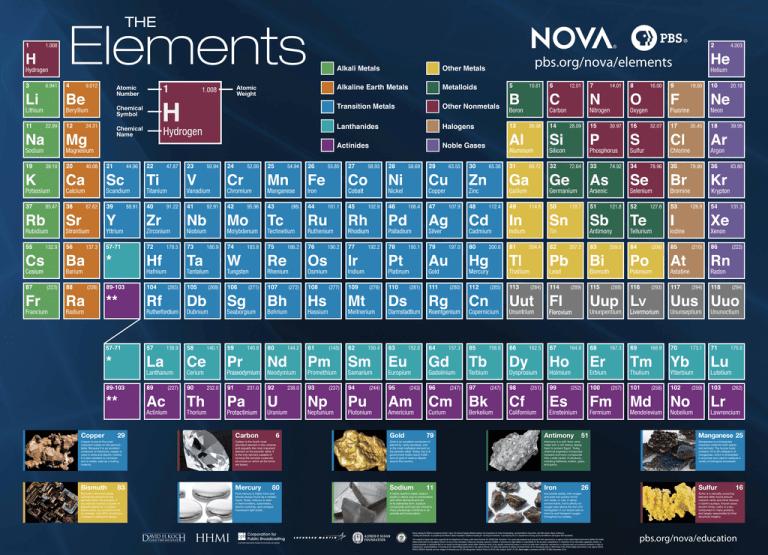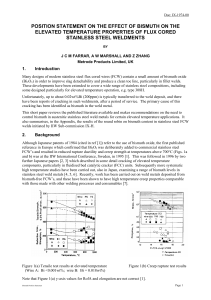pbs.org/nova/elements
advertisement

THE 1.008 6.941 Elements 9.012 Atomic Number 1.008 Atomic Weight Chemical Symbol 22.99 24.31 Chemical Name 4.003 pbs.org/nova/elements Alkali Metals Other Metals Alkaline Earth Metals Metalloids Transition Metals Other Nonmetals Lanthanides Halogens Actinides Noble Gases 10.81 12.01 14.01 16.00 19.00 20.18 26.98 28.09 30.97 32.07 35.45 39.95 39.10 40.08 44.96 47.87 50.94 52.00 54.94 55.85 58.93 58.69 63.55 65.38 69.72 72.64 74.92 78.96 79.90 83.80 85.47 87.62 88.91 91.22 92.91 95.96 (98) 101.1 102.9 106.4 107.9 112.4 114.8 118.7 121.8 127.6 126.9 131.3 132.9 137.3 178.5 180.9 183.8 186.2 190.2 192.2 195.1 197.0 200.6 204.4 207.2 209.0 (209) (210) (222) (223) (226) (265) (268) (271) (272) (277) (276) (281) (280) (285) (284) (289) (288) (293) (294) (294) Livermorium Flerovium 138.9 140.1 140.9 144.2 (145) 150.4 152.0 157.3 158.9 162.5 164.9 167.3 168.9 173.1 175.0 (227) 232.0 231.0 238.0 (237) (244) (243) (247) (247) (251) (252) (257) (258) (259) (262) Copper 29 Carbon 6 Bismuth 83 Mercury 80 Copper is one of the most important metals on the periodic table. Because it is an excellent conductor of electricity, copper is used in wires and electric motors. It is also resistant to corrosion and is widely used as a roofing material. Bismuth is the most stable radioactive element on the periodic table. For example, if you were to monitor a cluster of bismuth atoms for 1.9 billionbillion years, you would find that, on average, only 50% would have undergone radioactive decay. Carbon is the fourth most abundant element in the universe and arguably the most important element on the periodic table. It is the only element capable of forming the complex molecular structures on which all life forms are based. Pure mercury is highly toxic and almost always found as a metallic liquid. Today, mercury is used in thermometers, barometers, electric switches, and compact fluorescent light bulbs. Gold 79 Antimony 51 Manganese 25 Sodium 11 Iron 26 Sulfur Gold is an excellent conductor of electricity, rarely tarnishes, and is the most malleable element on the periodic table. Today, the U.S. government holds nearly 9,000 tons of gold in reserve depots around the country. A highly reactive metal, sodium exists in nature only in combination with other elements and not in its elemental form. Sodium compounds and ions are critical to many physiologic functions in all animals and some plants. Antimony is a soft, toxic semimetal with a rich history dating back to ancient Egypt. Today, chemical engineers incorporate nontoxic antimony compounds into a wide variety of products, including batteries, bullets, glass, and paints. Iron bonds readily with oxygen and pure iron quickly forms iron oxide, or rust, in damp environments. Iron’s affinity for oxygen also allows the iron-rich hemoglobin in our blood cells to bond to and transport oxygen throughout our bodies. Series funding for NOVA is provided by David H. Koch, the Howard Hughes Medical Institute, the Corporation for Public Broadcasting, Lockheed Martin Corporation, and PBS viewers. Major funding for “Hunting the Elements” is provided by the Alfred P. Sloan Foundation. Additional funding for “Hunting the Elements” is provided by the U.S. Department of Energy and by the Millicent and Eugene Bell Foundation. This material is based upon work supported by the Department of Energy under Award Number DE-SC0007358. Disclaimer: This report was prepared as an account of work sponsored by an agency of the United States Government. Neither the United States Government nor any agency thereof, nor any of their employees, makes any warranty, express or implied, or assumes any legal liability or responsibility for the accuracy, completeness, or usefulness of any information, apparatus, product, or process disclosed, or represents that its use would not infringe privately owned rights. Reference herein to any specific commercial product, or service by trade name, trademark, manufacturer, or otherwise does not necessarily constitute or imply its endorsement, recommendations, or favoring by the United States Government or any agency thereof. The views and opinions of authors expressed herein do not necessarily state or reflect those of the United States Government or any agency thereof. PHOTO CREDITS: Bismuth and Iron: images-of-elements.com (CC BY), Manganese: Heinrich Poink (CC BY-NC-ND), Sodium: Dnn87 (CC BY). Atomic weight is consistent with NIST SP 966 (September 2010). Manganese is a biologically important metal for both plants and animals. The human body contains 10 to 20 milligrams of manganese, which is embedded in enzymes and used to catalyze a variety of biological processes. 16 Sulfur is a naturally occurring element often found around volcanic vents and other fissures in Earth’s surface. Known since ancient times, sulfur is a key component in many proteins, and largely responsible for their structural integrity. pbs.org/nova/education


